
Sen. John Kerry conceded in a phone call to President Bush ending the 2004 presidential race. We hear Kerry’s concession speech followed by Bush’s acceptance speech. [includes rush transcript]
The presidential race is over. Senator John Kerry conceded in a phone call to President Bush yesterday morning ending the 2004 race.
Bush held a victory rally at the Ronald Reagan Building in Washington and appeared on stage with his family and Vice President Dick Cheney.
Bush enters his second term after winning the popular vote by 3.5 million. He is the first president to win more than 50 percent of the vote in 16 years. And the Republicans have strengthened its control of both the House and the Senate.
The Kerry campaign had vowed not to concede until every vote was counted in Ohio, but the Massachusetts Senator conceded yesterday after determining there were not enough uncounted voters to make up the difference.
At 11 a.m. Kerry called Bush and then addressed supporters a couple hours later in Boston. Kerry called on the nation to “begin the healing.”
Speaking at his victory rally, Bush said, “America has spoken and I’m humbled by the trust and confidence of my fellow citizens. With that trust comes a duty to serve all Americans and I will do my best to fulfill that duty every day as your president.”
- John Kerry, giving concession address, November 3, 2004.
- President Bush, giving acceptance speech, November 3, 2004.
Transcript
JUAN GONZALEZ: Yesterday afternoon, Senator Kerry conceded in a speech before supporters in Boston.
JOHN KERRY: You may not understand completely in what ways, but it is true when I say to you that you have taught me and you have tested me, and you have lifted me up, and you have made me stronger. I did my best to express my vision and my hopes for America. We worked hard, and we fought hard, and I wish that things had turned out a little differently, but in an American election, there are no losers, because whether or not our candidates are successful, the next morning we all wake up as Americans. And that — [ applause ] — that is the greatest privilege and the most remarkable good fortune that can come to us on earth. With that gift also comes obligation. We are required now to work together for the good of our country. In the days ahead, we must find common cause, We must join in common effort without remorse or recrimination without anger or rancor. America is in need of unity, and longing for a larger measure of compassion. I hope President Bush will advance those values in the coming years. I pledge to do my part, to try to bridge the partisan divide. I know this is a difficult time for my supporters, but I ask them, all of you, to join me in doing that. Now more than ever with our soldiers in harm’s way, we must stand together and succeed in Iraq and win the war on terror. I will also do everything in my power to insure that my party, a proud Democratic Party, stands true to our best hopes and ideals. I believe that what we started in this campaign will not end here. And I know —–[applause] — our fight goes on to put America back to work and make our economy a great engine of job growth. Our fight goes on to make affordable health care a — an accessible right for all Americans, not a privilege. Our fight goes on to protect the environment, to achieve equality to push the frontiers of science and discovery, and to restore America’s reputation in the world. I believe that all of this will happen, and sooner than we may think, because we’re America and America always moves forward.
AMY GOODMAN: A defeated senator John Kerry speaking at annual hall in Boston. Soon after, President Bush in Washington, D.C., held his victory party at the Ronald Reagan building.
GEORGE W. BUSH: Because we have done the hard work, we are entering a season of hope. We will continue our economic progress. We will reform our outdated tax code. We will strengthen the social security for the next generation. We will make public schools all they can be. And we will uphold our deepest values of family and faith. We will help the emerging democracies of Iraq and Afghanistan. [ cheers and applause ] so they can — so they can grow in strength, and defend their freedom, and then our service men and women will come home with the honor they have earned. [ cheers and applause ] With good allies at our side, we will fight this war on terror with every resource in our national power so our children can live in freedom, and in peace. Reaching these goals will require the broad support of Americans. So today I want to speak to every person who voted for my opponent. To make this nation stronger and better, I will need your support and I will work to earn it. I will do all I can do to deserve your trust. A new term is a new opportunity to reach out to the whole nation. We have one country, one constitution, and one future that binds us. And when we come together, and work together, there is no limit to the greatness of America. Let me close with a word to the people of the state of Texas — [ cheers and applause ] we have known each other the longest, and you have started me on this journey. On the open plains of Texas, I first learned the character of our country, sturdy and honest, and as hopeful as the break of day. I will always be grateful to the good people of my state, and whatever the road that lies ahead, that road will take me home. A campaign has ended and the United States of America goes forward with confidence and faith. I see a great day coming for our country, and I am eager for the work ahead. God bless you, and may God bless America.
AMY GOODMAN: President Bush speaking yesterday in Washington, D.C. This is Democracy Now!, democracynow.org. I’m Amy Goodman with Juan Gonzalez. Juan, you have been doing a lot of looking at the numbers, at the votes around the country.
JUAN GONZALEZ: Yes. I think that it’s very important in elections like this to try to really get a sense of what was happening on the ground. There’s a tendency often to look at the overall numbers, but anyone who has actually been involved in elections processes knows that what happens at the precinct level really determines pretty much what your picture of this election was. Some of the things that I have looked around the country yesterday, I spent quite a bit of time looking at the numbers, a few things struck me. Number one is the enormous consolidation of the African American vote, not only in terms of numbers, but in terms of percentages against the Republican Party. Washington, D.C., for instance, a much higher percentage of people voting for the Democrats, and larger numbers than last time. Duval county, the infamous Duval county in Jacksonville —
AMY GOODMAN: In Florida.
JUAN GONZALEZ: In Jacksonville, Florida. Huge turnouts in the black community, but also huge turnouts among whites in Duval county as well. So that there was a 44% increase in the black — in the Democratic turnout and a 42% increase in the Republican turnout. Enormous increases. At the same time, the other thing is the enormous problems with our electoral system. It’s unbelievable — it’s astounding that people had to wait ten hours in some places in Ohio to vote. One fellow reporter of mine at the New York Daily News spent five-and-a-half hours on line in eastern Pennsylvania when he went home in the evening to vote. It’s unbelievable that in a country as advanced as we are, that people have to virtually spend a whole day to vote in some of these urban areas. Then, of course, voting being like — making sausage, when you see the actual numbers, I think Greg Palast mentioned a little bit about New Mexico, but I took a closer look at New Mexico yesterday, and I’m astounded at the vote results. There’s no way that you can tell what happened in New Mexico right now. Just to give you an example in Taos county in just one — one electoral district that the state posted the returns on yesterday, out of 505 people who voted, according to the county, and that just that one precinct, only 359 votes have been tallied. 146 are missing. At least there’s no apparent indication of how 30% of the people in that one precinct voted. In other precincts, hundreds of votes more than the number of people who the state says actually voted.
AMY GOODMAN: In the example of Taos, and you say 30%. You don’t even know how they voted. How about the others? How did they skew?
JUAN GONZALEZ: Well, overwhelmingly, there’s about, from what I can tell in New Mexico there’s about 7,000 unaccounted for votes that people who actually voted and supposedly the votes are in, but when you add up the presidential candidates votes and everyone under that, none of them totaled the same number, so you are looking at maybe 7,000 who just either for some reason or other, their votes were discounted, or they don’t appear. And — so, I would say that given the fact that it’s about 13,000, I think that the difference is there, that’s very, very hard to tell what is happening in New Mexico in terms of who will be eventually declared the winner.
AMY GOODMAN: What’s interesting about Taos is that it’s probably one of the most democratically concentrated areas of New Mexico.
JUAN GONZALEZ: Yes it’s also — for instance, San Juan County in New Mexico, that’s 52% native American and Latino, but yet somehow turned up 65% for Cheney and Bush, and 823 votes there are missing in that county. And so that there are quite a few places throughout New Mexico where I think there has to be a closer look. And I think in Ohio, one of the things that amazed me about the results posted by the state so far, is that they’re only at the county level. They’re not at the precinct level. You really don’t know what’s happened in Ohio yet, until you see the precinct level votes, which is how most people identify, you know, their communities and their neighborhoods, you can get a better idea. So, I think that the — as I spoke to quite a few returning New Yorkers, who were in New Mexico and Ohio, who are on their way back now, one of the — I remember one particular person who grew up in southern Ohio and spent months there during this past year in Cincinnati trying to turn out the Democratic vote, he told me, and this is a — a white labor activist here in New York, he told me, you know, I know southern Ohio. And ultimately, it’s about — it was about race. Race was the one question — the one thing that was not talked about in this election, but the — the Democratic Party has become the party of black people in America. And many — and of Hispanics and immigrants. Many of the people who were voting know that, and came out in large numbers, and that increasingly, the — this conservative and racist — racist vote, which in large measure, it is, has consolidated itself in its opposition to the Democratic Party and the party of black people. That explains the enormous consolidation of the Republican rule in the south. It used to be that the Democratic Party had all of the racist Dixiecrats in it. Now all of the Dixiecrats have left the Democratic Party. I guess the last one was — what’s his name that’s escaping me now at the Republican convention —- the -—
AMY GOODMAN: Zell Miller.
JUAN GONZALEZ: Zell Miller was one of the last of the Dixiecrats who finally moved over, but essentially, all of the Dixiecrats and their constituents in the south have moved into the Republican Party. That’s created the enormous consolidated vote, Republican Party vote in the South.

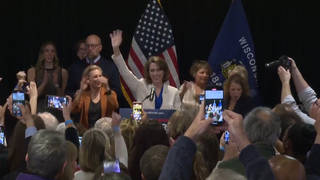
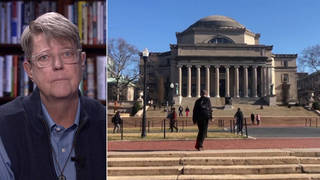
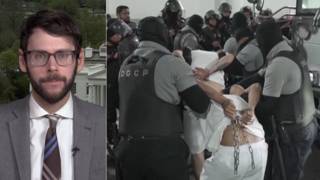
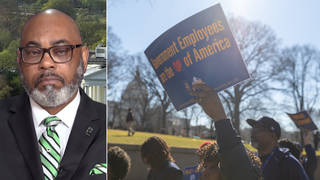





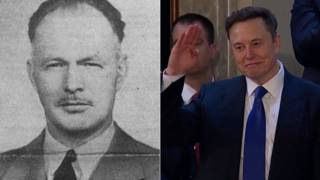
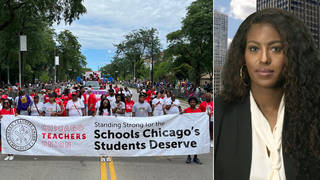
Media Options